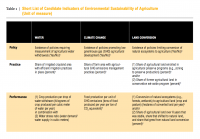-
Featured Rights to Resources
The data included in this spreadsheet were downloaded from the World Resource Institute's Rights to Resources interactive map. The Rights to Resources interactive map presents the results of a legal review of national laws in sub-Saharan Africa in their treatment of local-use rights to natural...
-
World's Average Monthly Rainfall in November
This data was used in Map 3.5 in Nature's Benefits in Kenya: An Atlas of Ecosystems and Human Well-Being.
-
World's Average Monthly Rainfall in July
This data was used in Map 3.4 in Nature's Benefits in Kenya: An Atlas of Ecosystems and Human Well-Being.
-
World's Average Monthly Rainfall in April
This data was used in Map 3.3 in Nature's Benefits in Kenya: An Atlas of Ecosystems and Human Well-Being.
-
World's average monthly rainfall in February
This data was used in Map 3.2 in Nature's Benefits in Kenya: An Atlas of Ecosystems and Human Well-Being.
-
Marine Protected Areas in Coral Reef Regions of the World
This dataset is part of the base data used for Reefs at Risk Revisited. To assess the level of protection and management for coral reefs around the world. The map of MPAs and associated management effectiveness scores were used to adjust pressure from overfishing and destructive fishing in the...
-
Tropical Coral Reefs of the World (500-m resolution grid)
Global map of shallow, tropical coral reefs, gridded at 500-m resolution for use in the Reefs at Risk Revisited project. The coral reef location data were compiled from multiple sources by UNEP-WCMC, the WorldFish Center, and WRI. To standardize these data for the purposes of the Reefs at Risk...
-
Indicators of Sustainable Agriculture: A Scoping Analysis
The spreadsheet “Evaluation of Candidate Indicators of Environmental Sustainability of Agriculture” presents the complete list of candidate indicators that were considered in the scoping analysis as well as the results of an assessment that determined the suitability of these candidate indicators...
-
Fast-Start Finance Contributions
This workbook contains data from a detailed review of the 2010-2012 fast-start finance (FSF) contributions of five countries reporting the largest FSF contributions (Germany, Japan, Norway, the UK, and the USA) and from a supplemental review of the remaining FSF contributions from 31 additional...
-
Datasheet for Technical Note: A Breakdown of Developed Countries’ Public Clim...
This dataset contains a breakdown of developed countries individual public contributions in public climate finance towards the $100 billion commitment between 2013-2018. This dataset was used in WRI’s technical note ‘A Breakdown of Developed Countries’ Public Climate Finance Contributions Towards...
-
Coral reefs in Kenya
This data was used in Map 6.4 and Map 6.5 in Nature's Benefits in Kenya: An Atlas of Ecosystems and Human Well-Being. The full report is available at http://www.geus.dk/program-areas/nature-environment/international/reports/kensea/kensea_rapport.pdf.
-
Percent woodlots in sampled cropland in Kenya
This data was used in Map 7.3 in Nature's Benefits in Kenya: An Atlas of Ecosystems and Human Well-Being. These data combine detailed crop information from 5,747 aerial photos for a growing season in 1997, each providing a sample point of detailed crop information. These samples were averaged...
-
Percentage Food Crops in Central and Western Kenya
World Agroforestry Center (ICRAF) and Department of Resource Surveys and Remote Sensing (DRSRS), Ministry of Environment and Natural Resources. 2001. GIS Database of Land Use and Land Cover for Kenya's Medium to High Potential Districts. DRSRS interpretation of 5,747 aerial photographs from...
-
Average number of crops grown in croplands of central and western Kenya, 1997
World Agroforestry Center (ICRAF) and Department of Resource Surveys and Remote Sensing (DRSRS), Ministry of Environment and Natural Resources. 2001. GIS Database of Land Use and Land Cover for Kenya's Medium to High Potential Districts. DRSRS interpretation of 5,747 aerial photographs from...
-
Spatial distribution of observed zebra numbers in Kenya, 1994-1996
This data was used in Map 6.2 in Nature's Benefits in Kenya: An Atlas of Ecosystems and Human Well-Being. Wildlife counts come from a rangeland census using low-altitude flights in Kenya. Numbers of animals observed were aggregated to 5km grid cells. Note: A number of zebra nul should be...
-
Wildlife density in Kenya's rangelands: 1994-96
This data was used in Map 1.4, Map 4.10, and Map 5.11 in Nature's Benefits in Kenya: An Atlas of Ecosystems and Human Well-Being. Species numbers are aggregated using a ""tropical livestock unit"" (TLU) (which is equivalent to an animal weight of 250 kilograms) to grid cells of 5x5 km and then...
-
Wildlife density in Kenya's rangelands, 1977-78
This data was used in Map 5.10 in Nature's Benefits in Kenya: An Atlas of Ecosystems and Human Well-Being. Species numbers were aggregated using a ""tropical livestock unit"" (TLU) (which is equivalent to an animal weight of 250 kilograms) to grid cells of 5x5 km and then averaged by square...
-
Change in wildlife density in Kenya's rangelands between 1977-78 and 1994-96
This data was used in Map 5.12 in Nature's Benefits in Kenya: An Atlas of Ecosystems and Human Well-Being. Species numbers were aggregated using a ""tropical livestock unit"" (TLU) (which is equivalent to an animal weight of 250 kilograms) to grid cells of 10x10 km and then averaged by square...
-
Spatial distribution of observed wildebeest numbers in Kenya, 1994-1996
This data was used in Map 6.2 in Nature's Benefits in Kenya: An Atlas of Ecosystems and Human Well-Being. Wildlife counts come from a rangeland census using low-altitude flights in Kenya. Numbers of animals observed were aggregated to 5km grid cells. Note: A number of wildebeest nul should be...
-
Spatial distribution of observed giraffe numbers in Kenya, 1994-1996
This data was used in Map 6.2 in Nature's Benefits in Kenya: An Atlas of Ecosystems and Human Well-Being. Wildlife counts come from a rangeland census using low-altitude flights in Kenya. Numbers of animals observed were aggregated to 5km grid cells. Note: A number of giraffes nul should be...
